![]()
![]()
![]()
Use LEFT and RIGHT arrow keys to navigate between flashcards;
Use UP and DOWN arrow keys to flip the card;
H to show hint;
A reads text to speech;
39 Cards in this Set
- Front
- Back
|
What is a tumour |
A 'swelling' not neccesarily neoplastic |
|
|
What is a neoplasm |
An abnormal mass of tissue, the growth of which exceeds and is un-coordinated (different to) adjacent tissue. Continues to grow after removal of stimulus that provoked the change |
|
|
What is the difference between benign and malignant neoplasm |
Benign: HARMLESS
Malignant: HARMFUL |
|
|
What are the reasons that a benign neoplasm could still threaten life |
Meningioma - raised intracranial pressure
|
|
|
WHat is histogenesis |
The cellular origin of a neoplasm |
|
|
What is differentiation: |
The degree to which a neoplasm resembles its normal of origin
Well differentiated - close resemblance Vice versa |
|
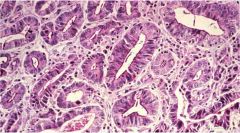
how differentiated is this adenocarcinoma |
Well differentiated |
|

how differentiated is this adenocarcinoma |
Poorly differentiated |
|
|
What is anaplasia |
Complete lack of differentiation in a neoplasm |
|
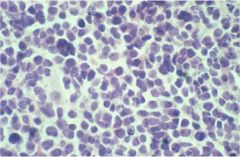
What is this |
Small cell anaplastic carcinoma |
|
|
How are benign neoplasms classified |
Generally end in OMA
eg papilloma adenoma lipoma |
|
|
What are the benign neoplasms called in these cells
Stratified squamous epithelium
Transition cell epithelium
Glandular epithelium |
SSE- Squamous cell papilloma
TCE - Transitional cell papilloma
Gl - Adenoma |
|
|
What are the names of the benign neoplasms in these connective tissues
Fat Smooth Muscle Nerve Striated muscle Endothelium |
F- Lipoma SM -Leiomyoma N- Neurofibroma SM - Rhabdomyoma E - Haemangioma |
|
|
What malignant tumours end in oma |
Lymphoma Myeloma Melanoma Mesthelioma
|
|
|
What are the names of the malignant neoplasms
Epithelial tissue Connective tissue Embryonic tissue |
Epithelium - carcinoma connective - sarcoma Embryonic - blastoma |
|
|
What are the names of these malignant neoplasms
Stratified squamous epithelium Transition cell epithelium Glandular epithelium |
SSE - Squamous cell carcinoma TCE - Transitional cell carcinoma GE- Adenocarcinoma |
|
|
What are the names of these malignant tissue neoplasms?
Fat Smooth muscle Nerve Striated muscle Endothelium
|
F- Liposarcoma SM-Leiomyosarcoma N-Neurofibrosarcoma STRM-Rhabdomyosarcoma E- Haemangiosarcoma |
|
|
Rules of nomenclature?
|
Sarcoma is for connective tissue Carcinoma is for tissue cancers (epithelium) OMA Is for benign tumours (mostly) |
|
|
WHat are the names of these malignant embryonic neoplasms?
Kidney Neural tissue Retina |
Kidney - Nephroblastoma N-Neuroblastoma R- Retinoblastoma |
|
|
What are germ cell neoplasms? Where are they found? WHat are they calle?
|
Germ cells are found in ovary and testis Neoplasms derived from germ cells are called teratomas Teratomas differentiate along more than one germ cell line Can be benign or malignant |
|
|
What are the features of benign and malignant neoplasms? Macroscopic and microscopic appearance? |
Benign Macroscopic: Well defined outline, smooth surface B Micro - Blunt pushing
Malignant Macroscopic - Irregular or ill defined outline, craggy surface
M Micro - Infiltrative, invasive |
|
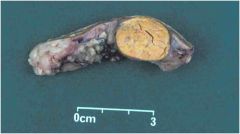
Is this benign or malignant |
Benign |
|
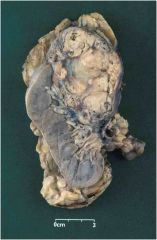
Is this benign or malignant? |
malignant |
|
|
Features of Benign and malignant? |
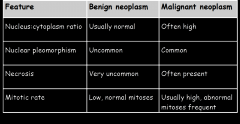
|
|
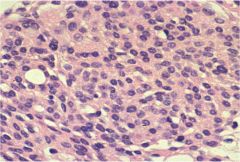
where is this |
the meninges Menningioma- nuclei regular, little pleomorphism |
|

What is leiomyoma? |
Nuclei regular, little pleomorphism |
|

what is a leiomyosarcoma |
Nuclei irregular, pleomorphism + giant bizarre cells |
|
|
What is metastasis? |
A secondary growth of a neoplasm at one or more locations distant from primary site Only occurs with malignant neoplasms Spread via Lymphatics Blood vessels across mesothelial lined cavities Through cerebrospinal fluid |
|
|
Mecahnims of invasion and metastasis? |
1) detatching from tumour 2) attatching to ECM via receptors 3) secretion of proteases and collagenases. break down ECM 4) movement through ECM via secretionof motility factors 5) entry into blood vessel, interacts with lymphocytes. Formating of tumour embolus 6) Adhesion to endothelium at distant site via adhesion molecules 7) vascular extravasation, regrowth of a metastatic clone. |
|
|
Explain the process of metastasis? |
1) clonal expansion 2) adhesion to basement membrane, passage through ECM intravasion 3) Host lymphocyte, coating with platelets 4) embolization, extravasation growth |
|
|
What are the patterns of metastasis |
Carcinomas: via lymphatics and lymph nodes EARLY Blood stream LATE Sarcomas : Blood stream EARLY
|
|
|
Effects of neoplasm on host |
Pain Anaemia, Fever Immune Paresis CACHEXIA Paraneoplastic DEATH EPTOPIC HORMONES |
|
|
What are the paraneoplastic effects on host |
Thrombosis DIC and NBTE Dermatoses Neuropathies Clubbing Bone Changes Renal disease |
|
|
Why is it common (ANAEMIA) |
Haemmorrhage from neoplasm Decreased life span of erythrocytes Replacement of bone marrow by metastatic tumour Autoantibodies against red cell |
|
|
Why does autoantibodies cause cancer |
Replacement of haematopoietic marrow by cancer = decreased life span of erythrocytes |
|
|
What is cancer cachexia |
Weight loss, anorexia, fever and weakness are common in patients with advanced malignany Probably results from cytokines (TNF -a, IL1, IFgamma) secreted by the tumour or reactive host cells Underlying metabolic changes are obscure |
|
|
Paraneoplastic syndromes |
Symtom complexes in patients with malignant disease that cannot be explained by local or distant spread of the neoplasm or by hormone production from the tissue in which the neoplasm arose. |
|
|
WHat are some paraneoplastic endocrinopathies |

|
|
|
Why do patients die from cancer |
Widespread disease in multiple organ sites Metastatic disease in vital sites Immunosuppression -> opportunistic infections Organ failure Haemorrhage Late second malignancies |

